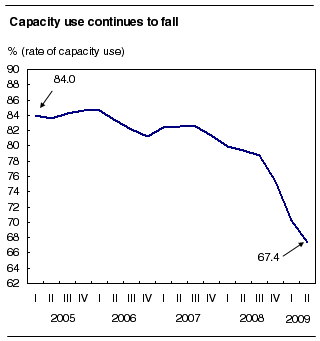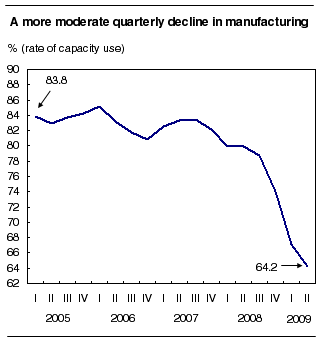Common menu bar links
Industrial capacity utilization rates
Archived Content
Information identified as archived is provided for reference, research or recordkeeping purposes. It is not subject to the Government of Canada Web Standards and has not been altered or updated since it was archived. Please "contact us" to request a format other than those available.
Canadian industries lowered their rate of capacity utilization by 2.8 percentage points to 67.4% in the second quarter, a much smaller decline than the decrease of 5.2 percentage points in the first quarter. However, industrial capacity use still reached its lowest level since the start of the data series in 1987.

All sectors except food manufacturing saw their capacity use fall, albeit at a slower pace compared with the first quarter.
Of the 21 major industries in the manufacturing group, 20 used less of their production capacity in the second quarter, reflecting the weak demand for manufactured goods. The utilization rate in the transportation equipment industry fell 0.9 percentage points to 46.0%, after decreasing 12.1 points in the first quarter of 2009 and 9.2 points in the fourth quarter of 2008.
The primary metal manufacturing industry led the decline in the manufacturing group. Capacity use in this industry fell to 61.9%, the lowest level on record and well below the peak of 97.6% in the third quarter of 2008.
In the non-manufacturing group, capacity use fell in all sectors with the most notable drop posted by the mining and oil and gas extraction sector. The mining sector operated at 50.2% of its production capacity in the second quarter, down from 56.5% in the first quarter, while the oil and gas extraction sector cut capacity use by 1.9 percentage points to 76.1%, completely erasing the 1.2 percentage point gain registered in the first quarter.
Note to readers
The industrial capacity utilization rate is the ratio of an industry's actual output to its estimated potential output.
For this release, rates have been revised back to the first quarter of 2007 to reflect the revised source data.
Manufacturing: A more moderate quarterly decline in capacity use
In the second quarter, manufacturers reduced their use of production capacity for a fourth consecutive quarter to 64.2%, compared with 67.1% in the first quarter of 2009 and 79.9% in the second quarter of 2008. This was a more moderate quarterly decline in capacity use than in the first quarter of 2009.
Both non-durable and durable goods-producing industries, particularly primary metal, fabricated metal product, machinery manufacturing industries and, to a lesser extent, transportation equipment industry, contributed to the lower rate in the manufacturing group. The above four industries represent more than one-third of output in total manufacturing.

In the primary metal manufacturing industry, weak demand and temporary plant closures led to a sharp decline in the production of all main components in this industry, with the exception of alumina and aluminum production and processing. As a result, the capacity use fell 10.2 percentage points to 61.9%. This was the third consecutive double-digit quarterly decline.
Machinery manufacturers used 67.0% of their production capacity in the second quarter, down 7.0 percentage points from the first quarter. The substantial cutback in output by mining and oil and gas field machinery manufacturers and metalworking machinery manufacturers played a key role in pushing down the rate in this industry.
Capacity use in fabricated metal product manufacturing continued its downward trend, which started in the first quarter of 2008, dropping from 70.1% in the first quarter of 2009 to 65.9% in the second quarter. A 4.9% reduction in production for the majority of the main components in this industry was behind the drop in the rate.
The utilization rate in the transportation equipment industry fell 0.9 percentage points to 46.0%, reflecting a 1.2% cutback in production. The 6.1% increase in motor vehicle manufacturing was more than offset by the production decrease from other key components in this industry, including motor vehicle parts and aerospace product and parts manufacturing.
In the food manufacturing industry, industrial capacity utilization settled at 81.5% in the second quarter, remaining unchanged from the first quarter. The 0.2% rise in production in this industry was entirely absorbed by the slight growth in production capacity.
Non-manufacturing: Mining and oil and gas extraction led the decline
In the non-manufacturing group, capacity use declined in all sectors in the second quarter, led by the mining and oil and gas extraction sector.
After posting a positive result in the first quarter, the utilization rate in the oil and gas extraction sector dropped 1.9 percentage points to 76.1%, as production of both crude petroleum and natural gas contracted in the second quarter.
In the mining sector, excluding oil and gas extraction, capacity use fell 6.3 percentage points to 50.2%, a less pronounced decline compared with 14.5 points drop in the first quarter. Large decreases in output of metal ore, non-metallic mineral mining and support activities for mining, and oil and gas extraction, all contributed to the rate reduction.
The forestry and logging sector operated at 64.2% of its capacity in the second quarter, down 7.8 percentage points from the first quarter. This was mainly due to a 13.0% drop in production, as a result of continued weak demand for wood products.
In the construction sector, the rate declined from 73.0% to 71.1%, largely the result of a 2.1% decrease in production. Capacity use in the electric power generation, transmission and distribution sector slipped to 78.8%, a reflection of lower demand for electricity.
Available on CANSIM: table 028-0002.
Definitions, data sources and methods: survey number 2821.
Data on industrial capacity utilization rates for the third quarter of 2009 will be released on December 14.
For more information, or to enquire about the concepts, methods or data quality of this release, contact Xiang Zhou (613-951-0457; xiang.zhou@statcan.gc.ca), Investment and Capital Stock Division.
Table 1
| Fourth quarter 2008r | First quarter 2009r | Second quarter 2009 | Fourth quarter 2008 to first quarter 2009 | First to second quarter 2009 | |
|---|---|---|---|---|---|
| % | percentage point change | ||||
| Total industrial | 75.4 | 70.2 | 67.4 | -5.2 | -2.8 |
| Forestry and logging | 74.3 | 72.0 | 64.2 | -2.3 | -7.8 |
| Mining and oil and gas extraction | 75.1 | 71.5 | 68.2 | -3.6 | -3.3 |
| Oil and gas extraction | 76.8 | 78.0 | 76.1 | 1.2 | -1.9 |
| Mining | 71.0 | 56.5 | 50.2 | -14.5 | -6.3 |
| Electric power generation, transmission and distribution | 82.8 | 80.6 | 78.8 | -2.2 | -1.8 |
| Construction | 76.8 | 73.0 | 71.1 | -3.8 | -1.9 |
| Manufacturing | 74.0 | 67.1 | 64.2 | -6.9 | -2.9 |
| Food | 80.5 | 81.5 | 81.5 | 1.0 | 0.0 |
| Beverage and tobacco products | 72.5 | 73.7 | 70.3 | 1.2 | -3.4 |
| Beverage | 73.5 | 73.9 | 70.4 | 0.4 | -3.5 |
| Tobacco | 66.1 | 72.2 | 70.0 | 6.1 | -2.2 |
| Textile mills | 65.3 | 59.3 | 54.2 | -6.0 | -5.1 |
| Textile product mills | 75.0 | 64.5 | 53.4 | -10.5 | -11.1 |
| Clothing | 70.6 | 67.8 | 60.8 | -2.8 | -7.0 |
| Leather and allied products | 76.7 | 77.7 | 71.4 | 1.0 | -6.3 |
| Wood products | 69.3 | 62.2 | 59.2 | -7.1 | -3.0 |
| Paper | 81.3 | 77.0 | 73.1 | -4.3 | -3.9 |
| Printing and related support activities | 69.7 | 66.1 | 63.6 | -3.6 | -2.5 |
| Petroleum and coal products | 79.7 | 79.5 | 76.7 | -0.2 | -2.8 |
| Chemical | 78.8 | 74.7 | 72.7 | -4.1 | -2.0 |
| Plastics and rubber products | 68.5 | 61.6 | 57.4 | -6.9 | -4.2 |
| Plastic products | 67.3 | 60.4 | 56.8 | -6.9 | -3.6 |
| Rubber products | 74.2 | 67.1 | 60.3 | -7.1 | -6.8 |
| Non-metallic mineral products | 77.6 | 65.0 | 62.8 | -12.6 | -2.2 |
| Primary metal | 84.1 | 72.1 | 61.9 | -12.0 | -10.2 |
| Fabricated metal products | 77.2 | 70.1 | 65.9 | -7.1 | -4.2 |
| Machinery | 81.8 | 74.0 | 67.0 | -7.8 | -7.0 |
| Computer and electronic products | 85.4 | 81.9 | 80.7 | -3.5 | -1.2 |
| Electrical equipment, appliance and component | 85.2 | 76.5 | 74.1 | -8.7 | -2.4 |
| Transportation equipment | 59.0 | 46.9 | 46.0 | -12.1 | -0.9 |
| Furniture and related products | 74.1 | 66.9 | 63.5 | -7.2 | -3.4 |
| Miscellaneous manufacturing | 78.6 | 75.4 | 75.3 | -3.2 | -0.1 |

